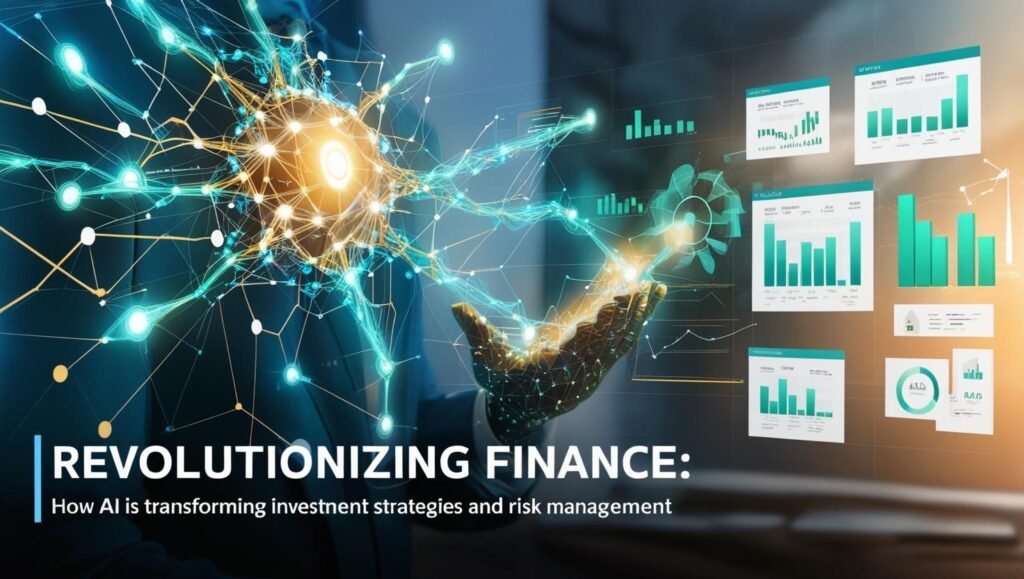Revolutionizing Finance: How AI is Transforming Investment Strategies and Risk Management

In today’s fast-paced financial landscape, artificial intelligence (AI) is emerging as a game-changer, redefining how investors navigate markets and manage risk. As the traditional paradigms of finance evolve, AI is not just enhancing investment strategies; it’s revolutionizing them.
From predictive analytics that forecast market trends to sophisticated algorithms that assess risk with unprecedented accuracy, AI is empowering investors to make data-driven decisions like never before. The integration of machine learning and big data analytics is enabling finance professionals to identify opportunities and mitigate risks in real-time, ensuring they stay ahead of the curve.
In this article, we delve into the transformative impact of AI on investment strategies and risk management, exploring how these innovations are reshaping the future of finance and equipping investors with the tools necessary for success in an increasingly complex market.
Join us as we uncover the advancements that are setting the stage for a new era in finance.
The Role of AI in Investment Strategies
Artificial intelligence (AI) is increasingly becoming an integral component in the realm of investment strategies. By leveraging AI’s computational power, financial analysts can now identify patterns and trends that were previously invisible to the human eye.
Traditional investment strategies relied heavily on historical data and human intuition. However, AI shifts the paradigm by incorporating vast amounts of data, including real-time market movements, social media sentiment, and even geopolitical events. This holistic data integration allows for more accurate predictions and timely investment decisions.
One of the primary advantages of AI in investment is its ability to process and analyze big data at an unparalleled speed and scale. Machine learning algorithms can sift through terabytes of data to identify correlations and causations that inform investment strategies.
For instance, AI can predict stock price movements based on historical trends, news articles, and even social media posts. This predictive capability provides investors with a significant edge, enabling them to capitalize on opportunities and avoid potential pitfalls.
Furthermore, AI-driven investment strategies are not static; they evolve over time. Machine learning models continuously learn from new data, refining their algorithms to improve accuracy and performance.
This adaptability is crucial in the ever-changing financial markets, where conditions can shift rapidly. By constantly updating their models, AI systems ensure that investment strategies remain relevant and effective, providing investors with a dynamic tool to navigate the complexities of the market.
Enhancing Risk Management with AI

Risk management is a critical aspect of finance, and AI is revolutionizing how this is approached. Traditional risk management relied on historical data and statistical models to predict potential risks.
However, these methods often fell short in the face of unprecedented events or black swan occurrences. AI, with its advanced algorithms and real-time data processing, offers a more robust solution for identifying and mitigating risks.
One of the key ways AI enhances risk management is through predictive analytics. By analyzing historical data along with current market conditions, AI can forecast potential risks and their impact on investments.
This predictive capability allows financial institutions to take preemptive measures, such as adjusting portfolios or implementing hedging strategies, to mitigate risk exposure. Moreover, AI can identify emerging risks that may not be immediately apparent, providing an added layer of protection for investors.
AI also excels in stress testing and scenario analysis. Financial institutions can use AI to simulate various market conditions and assess how their portfolios would perform under different scenarios. This helps in identifying vulnerabilities and making necessary adjustments to enhance resilience. For instance, AI can simulate the impact of a sudden economic downturn or a geopolitical crisis on a portfolio, allowing investors to prepare for such events.
Additionally, AI can monitor and analyze financial transactions in real-time, flagging any anomalies that may indicate fraudulent activities or market manipulation.
This real-time monitoring is crucial in preventing financial losses and maintaining the integrity of the financial system. By leveraging AI, financial institutions can ensure a more proactive and comprehensive approach to risk management.
Key AI Technologies Used in Finance
Artificial intelligence encompasses a range of technologies, each with its unique capabilities and applications in finance. Among these, machine learning, natural language processing (NLP), and neural networks stand out as the most impactful.
Machine learning, a subset of AI, involves training algorithms to recognize patterns in data and make predictions based on those patterns. In finance, machine learning is used for tasks such as credit scoring, fraud detection, and algorithmic trading.
For example, machine learning models can analyze historical credit data to predict the likelihood of default, helping lenders make more informed decisions.
Natural language processing (NLP) is another critical AI technology in finance. NLP enables machines to understand and interpret human language, making it possible to analyze vast amounts of unstructured data, such as news articles, financial reports, and social media posts.
This capability is particularly valuable for sentiment analysis, where AI can gauge market sentiment and predict its impact on stock prices. By understanding the context and sentiment behind news and social media posts, NLP provides investors with valuable insights into market dynamics.
Neural networks, inspired by the human brain, are particularly effective in recognizing complex patterns and relationships in data. In finance, neural networks are used for tasks such as portfolio optimization, risk assessment, and market prediction.
For instance, neural networks can analyze historical market data to identify patterns that indicate future price movements, helping investors make better trading decisions.
These AI technologies are often used in combination, creating powerful tools for financial analysis and decision-making. For example, a machine learning model can be enhanced with NLP to analyze textual data, while neural networks can further refine the model’s predictions.
By leveraging these technologies, financial institutions can gain deeper insights and make more informed decisions.
Case Studies: Successful AI Applications in Investment

The transformative power of AI in finance is best illustrated through real-world case studies. Several financial institutions and investment firms have successfully integrated AI into their operations, achieving remarkable results.
One notable example is BlackRock, the world’s largest asset manager. BlackRock has implemented AI-driven investment strategies through its Aladdin platform, which uses machine learning and big data analytics to manage risk and optimize portfolios.
The platform analyzes vast amounts of data, including market trends, economic indicators, and geopolitical events, to provide actionable insights. This has enabled BlackRock to enhance its investment strategies and deliver better returns for its clients.
Another compelling case study is that of Renaissance Technologies, a hedge fund known for its use of quantitative trading strategies. Renaissance Technologies employs AI and machine learning to analyze vast amounts of data and identify trading opportunities. The firm’s Medallion Fund, which relies heavily on AI-driven strategies, has consistently outperformed the market, delivering exceptional returns for its investors.
Goldman Sachs is another financial institution that has embraced AI to enhance its trading operations. The firm uses machine learning algorithms to analyze market data and make trading decisions in real-time. This has enabled Goldman Sachs to improve its trading performance and maintain a competitive edge in the fast-paced financial markets.
These case studies demonstrate the significant impact of AI on investment strategies and risk management. By leveraging AI, these firms have been able to achieve better performance, enhance risk management, and deliver superior returns for their clients.
Benefits of AI in Financial Decision-Making
The integration of AI into financial decision-making processes offers numerous benefits. One of the most significant advantages is the ability to make data-driven decisions.
AI can analyze vast amounts of data quickly and accurately, providing insights that human analysts might miss. This allows financial institutions to make more informed decisions, reducing the risk of errors and improving overall performance.
AI also enhances the speed and efficiency of financial operations. Traditional financial analysis can be time-consuming and labor-intensive, but AI automates many of these tasks, freeing up human analysts to focus on more complex and strategic activities. This increased efficiency can lead to faster decision-making and improved responsiveness to market changes.
Another key benefit of AI is its ability to identify and capitalize on investment opportunities. By analyzing market trends, economic indicators, and other data, AI can identify patterns and correlations that indicate potential investment opportunities. This enables investors to make more timely and profitable decisions, enhancing their overall returns.
AI also improves risk management by providing more accurate and timely assessments of potential risks. This allows financial institutions to take proactive measures to mitigate risk, reducing the likelihood of financial losses. Additionally, AI can monitor financial transactions in real-time, flagging any suspicious activity and preventing fraud.
Overall, the benefits of AI in financial decision-making are substantial, offering improved accuracy, efficiency, and profitability. By leveraging AI, financial institutions can enhance their operations, deliver better performance, and achieve a competitive edge in the market.
Challenges and Limitations of AI in Finance

While AI offers numerous benefits, it also comes with its own set of challenges and limitations. One of the primary challenges is the quality and reliability of data. AI models rely on large amounts of data to make accurate predictions and decisions.
However, if the data is incomplete, inaccurate, or biased, it can lead to incorrect conclusions and suboptimal decisions. Ensuring high-quality data is therefore critical for the success of AI in finance.
Another challenge is the complexity and opacity of AI models. Many AI algorithms, particularly deep learning models, operate as black boxes, meaning that their decision-making processes are not easily understood or interpreted.
This lack of transparency can be problematic in finance, where regulatory requirements and the need for accountability demand clear explanations of decision-making processes. Ensuring that AI models are interpretable and explainable is therefore an important consideration.
The integration of AI into existing financial systems and processes can also be challenging. Financial institutions often have legacy systems and infrastructure that may not be compatible with AI technologies. Upgrading these systems and ensuring seamless integration can be time-consuming and costly.
Additionally, there may be resistance to change from employees who are accustomed to traditional methods and may be wary of new technologies.
Ethical considerations also pose significant challenges for AI in finance. The use of AI raises questions about fairness, accountability, and the potential for bias. For example, if AI models are trained on biased data, they may perpetuate and even amplify existing biases, leading to unfair outcomes. Ensuring that AI is used ethically and responsibly is therefore a critical concern.
Despite these challenges, the potential benefits of AI in finance are significant. By addressing these challenges and ensuring careful implementation, financial institutions can harness the power of AI to enhance their operations and deliver better outcomes for their clients.
The Evolution of AI in Financial Services
The future of AI in financial services is promising, with several emerging trends set to shape the landscape. One of the most significant trends is the increasing use of AI for personalized financial services.
AI can analyze individual customer data to provide tailored financial advice, investment recommendations, and product offerings. This level of personalization can enhance customer satisfaction and loyalty, driving growth for financial institutions.
Another emerging trend is the use of AI for regulatory compliance and fraud detection. AI can analyze vast amounts of data to identify patterns and anomalies that indicate potential regulatory violations or fraudulent activities. This can help financial institutions comply with regulations more effectively and prevent financial crimes.
The integration of AI with blockchain technology is also an exciting development. Blockchain provides a secure and transparent way to record transactions, and when combined with AI, it can enhance the security and efficiency of financial operations. For example, AI can analyze blockchain data to detect fraudulent transactions and ensure the integrity of financial records.
The use of AI for sustainable finance is another emerging trend. AI can analyze environmental, social, and governance (ESG) data to assess the sustainability of investments and identify opportunities for green finance. This can help financial institutions align their investments with sustainability goals and contribute to a more sustainable future.
Overall, the future of AI in financial services is bright, with numerous opportunities for innovation and growth. By staying ahead of these trends and embracing new technologies, financial institutions can enhance their operations and deliver better outcomes for their clients.
Can We Trust AI with Our Money? The Ethics of Finance Automation

The use of AI in finance raises important ethical considerations that must be addressed to ensure responsible and fair use of technology. One of the primary ethical concerns is the potential for bias in AI models. If AI models are trained on biased data, they may perpetuate and even amplify existing biases, leading to unfair outcomes.
For example, biased credit scoring models may unfairly discriminate against certain groups of people, leading to unequal access to financial services. Ensuring that AI models are fair and unbiased is therefore a critical ethical consideration.
Another important ethical consideration is transparency and accountability. AI models, particularly deep learning models, often operate as black boxes, meaning that their decision-making processes are not easily understood or interpreted.
This lack of transparency can be problematic in finance, where regulatory requirements and the need for accountability demand clear explanations of decision-making processes. Ensuring that AI models are interpretable and explainable is therefore an important ethical consideration.
Privacy is another key ethical concern in AI-driven finance. AI models often rely on vast amounts of personal data to make predictions and decisions. Ensuring that this data is collected, stored, and used in a way that respects individuals’ privacy rights is critical. Financial institutions must implement robust data protection measures and ensure that they are transparent with customers about how their data is being used.
The use of AI also raises questions about the potential impact on employment. As AI automates many tasks traditionally performed by humans, there is a risk of job displacement. Ensuring that employees are supported through reskilling and upskilling initiatives is therefore an important ethical consideration.
Overall, the ethical considerations of AI in finance are significant and must be carefully addressed to ensure responsible and fair use of technology. By prioritizing ethics and ensuring that AI is used in a way that respects individuals’ rights and promotes fairness, financial institutions can harness the power of AI for the benefit of all.
Conclusion:
The integration of artificial intelligence into finance is revolutionizing investment strategies and risk management, offering significant benefits and opportunities for innovation.
From predictive analytics that forecast market trends to sophisticated algorithms that assess risk with unprecedented accuracy, AI is empowering investors to make data-driven decisions like never before. By leveraging AI, financial institutions can enhance their operations, deliver better performance, and achieve a competitive edge in the market.
However, the use of AI in finance also comes with its own set of challenges and ethical considerations. Ensuring high-quality data, transparency, accountability, and fairness is critical for the success of AI in finance. By addressing these challenges and prioritizing ethics, financial institutions can harness the power of AI responsibly and effectively.
The future of AI in financial services is promising, with numerous opportunities for innovation and growth. From personalized financial services to regulatory compliance, fraud detection, and sustainable finance, AI is set to transform the financial landscape in profound ways.
By staying ahead of these trends and embracing new technologies, financial institutions can navigate the complexities of the market and deliver better outcomes for their clients.
As we move towards a smarter financial future, it is essential to embrace AI and leverage its capabilities to enhance investment strategies and risk management. By doing so, we can create a more efficient, resilient, and fair financial system that benefits all stakeholders.
For the latest insights and updates, be sure to explore our AI Trends & News and stay ahead in the world of artificial intelligence.
